Wikipedia: Coral Reef
TED Talks: Laura Robinson – Mysterious ocean floor,
Kristen Marhaver – Re growing baby corals to rebuild reefs, David Gallo – Shows underwater astonishments and Margaret Wertheim – Crochets the coral reef
Gallery: Rebekah Barnett – What happens when you mix math, coral and crochet? It’s mind-blowing

Biodiversity of a coral reef
A Blue Starfish (Linckia laevigata) resting on hard Acropora and Porites corals (one can also see Anthiinae fish and crinoids). Lighthouse, Ribbon Reefs, Great Barrier Reef.
Copyright (c) 2004 Richard Ling
Coral reef Marine habitats
A coral reef is an underwater ecosystem characterized by reef-building corals. Reefs are formed of colonies of coral polyps held together by calcium carbonate. Most coral reefs are built from stony corals, whose polyps cluster in groups.
Coral belongs to the class Anthozoa in the animal phylum Cnidaria, which includes sea anemones and jellyfish. Unlike sea anemones, corals secrete hard carbonate exoskeletons that support and protect the coral. Most reefs grow best in warm, shallow, clear, sunny and agitated water.
Often called “rainforests of the sea”, shallow coral reefs form some of Earth’s most diverse ecosystems. They occupy less than 0.1% of the world’s ocean area, about half the area of France, yet they provide a home for at least 25% of all marine species,[1][2][3][4] including fish, mollusks, worms, crustaceans, echinoderms, sponges, tunicates and other cnidarians.[5] Coral reefs flourish in ocean waters that provide few nutrients. They are most commonly found at shallow depths in tropical waters, but deep water and cold water coral reefs exist on smaller scales in other areas.
Coral reefs deliver ecosystem services for tourism, fisheries and shoreline protection. The annual global economic value of coral reefs is estimated between US$30–375 billion[6][7] and 9.9 trillion USD.[8] Coral reefs are fragile, partly because they are sensitive to water conditions. They are under threat from excess nutrients (nitrogen and phosphorus), rising temperatures, oceanic acidification, overfishing (e.g., from blast fishing, cyanide fishing, spearfishing on scuba), sunscreen use,[9] and harmful land-use practices, including runoff and seeps (e.g., from injection wells and cesspools).[10][11][12]
Coral

Close up of polyps arrayed on a coral, waving their tentacles. There can be thousands of polyps on a single coral branch.
Coral detail
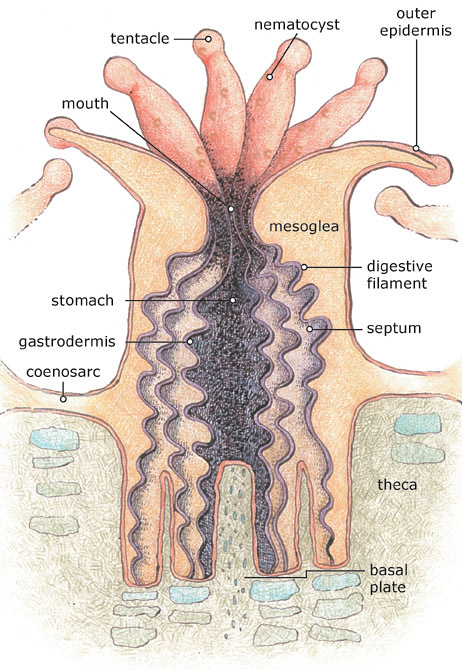
Diagram of a coral polyp anatomy.
NOAA – NOAA website
Anatomy of a coral polyp.
When alive, corals are colonies of small animals embedded in calcium carbonate shells. Coral heads consist of accumulations of individual animals called polyps, arranged in diverse shapes.[57] Polyps are usually tiny, but they can range in size from a pinhead to 12 inches (30 cm) across.
Reef-building or hermatypic corals live only in the photic zone (above 50 m), the depth to which sufficient sunlight penetrates the water.
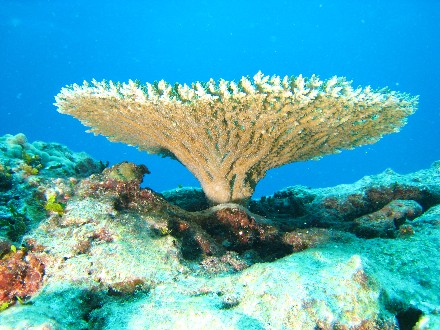
Yumi Yasutake, NOAA – https://www.hawaiianatolls.org/research/Sept_Oct2007/FFS.php
Table coral of genus Acropora (Acroporidae) at French Frigate Shoals, Northwestern Hawaiian Islands
Typical shapes for coral species are named by their resemblance to terrestrial objects such as wrinkled brains, cabbages, table tops, antlers, wire strands and pillars. These shapes can depend on the life history of the coral, like light exposure and wave action,[64] and events such as breakages.[65]
Reproduction
Corals reproduce both sexually and asexually. An individual polyp uses both reproductive modes within its lifetime. Corals reproduce sexually by either internal or external fertilization. The reproductive cells are found on the mesenteries, membranes that radiate inward from the layer of tissue that lines the stomach cavity. Some mature adult corals are hermaphroditic; others are exclusively male or female. A few species change sex as they grow.
Internally fertilized eggs develop in the polyp for a period ranging from days to weeks. Subsequent development produces a tiny larva, known as a planula. Externally fertilized eggs develop during synchronized spawning. Polyps across a reef simultaneously release eggs and sperm into the water en masse. Spawn disperse over a large area. The timing of spawning depends on time of year, water temperature, and tidal and lunar cycles. Spawning is most successful given little variation between high and low tide. The less water movement, the better the chance for fertilization. Ideal timing occurs in the spring. Release of eggs or planula usually occurs at night, and is sometimes in phase with the lunar cycle (three to six days after a full moon). The period from release to settlement lasts only a few days, but some planulae can survive afloat for several weeks. They are vulnerable to predation and environmental conditions. The lucky few planulae that successfully attach to substrate then compete for food and space.[citation needed]
Other reef builders
Corals are the most prodigious reef-builders. However many other organisms living in the reef community contribute skeletal calcium carbonate in the same manner as corals. These include coralline algae and some sponges.[66] Reefs are always built by the combined efforts of these different phyla, with different organisms leading reef-building in different geological periods.[citation needed]
Coralline algae

Corraline algae Lithothamnion sp.
Philippe Bourjon – The uploader on Wikimedia Commons received this from the author/copyright holder.
Une algue corallinale Lithothamnion sp. à la Réunion.
Coralline algae are important contributors to reef structure. Although their mineral deposition-rates are much slower than corals, they are more tolerant of rough wave-action, and so help to create a protective crust over those parts of the reef subjected to the greatest forces by waves, such as the reef front facing the open ocean. They also strengthen the reef structure by depositing limestone in sheets over the reef surface.[citation needed]
Sponges
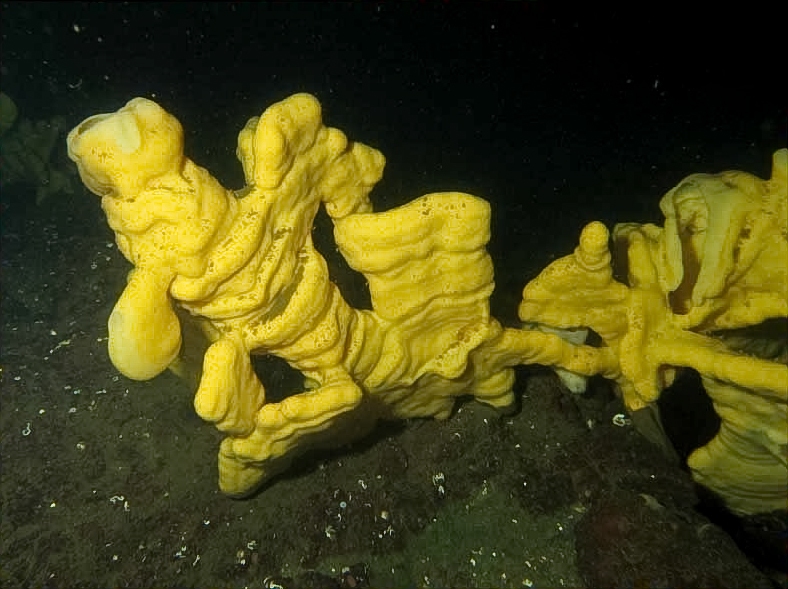
Deep-water cloud sponge
Deep-water cloud sponge
Caption:Aphrocallistes vastus. Cloud sponges are found down around 100′ in areas with little or no current. They are very fragile, as they are made out of tiny glass crystals (hydrated silica dioxide).
“Sclerosponge” is the descriptive name for all Porifera that build reefs. In the early Cambrian period, Archaeocyatha sponges were the world’s first reef-building organisms, and sponges were the only reef-builders until the Ordovician. Sclerosponges still assist corals building modern reefs, but like coralline algae are much slower-growing than corals and their contribution is (usually) minor.[citation needed]
In the northern Pacific Ocean cloud sponges still create deep-water mineral-structures without corals, although the structures are not recognizable from the surface like tropical reefs. They are the only extant organisms known to build reef-like structures in cold water.[citation needed]
Gallery of reef-building corals and their reef-building assistants
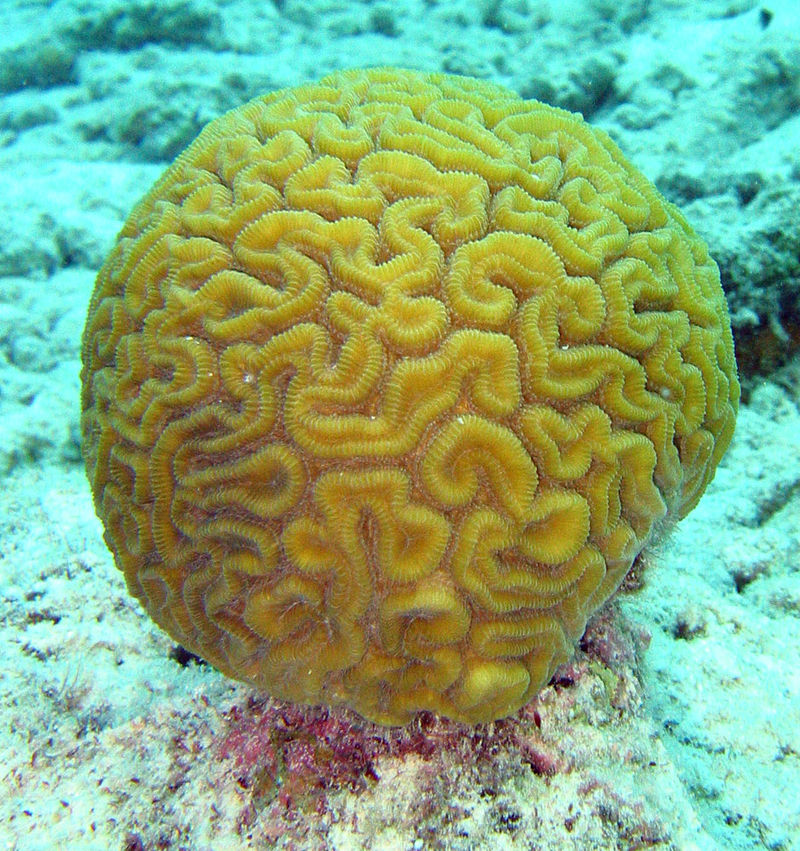
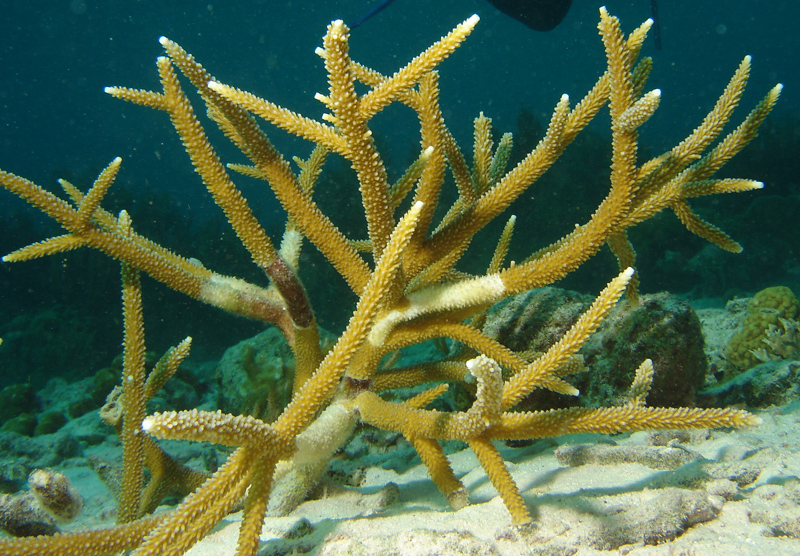
Adona9 at the English Wikipedia
Staghorn coral (Acropora cervicornis)
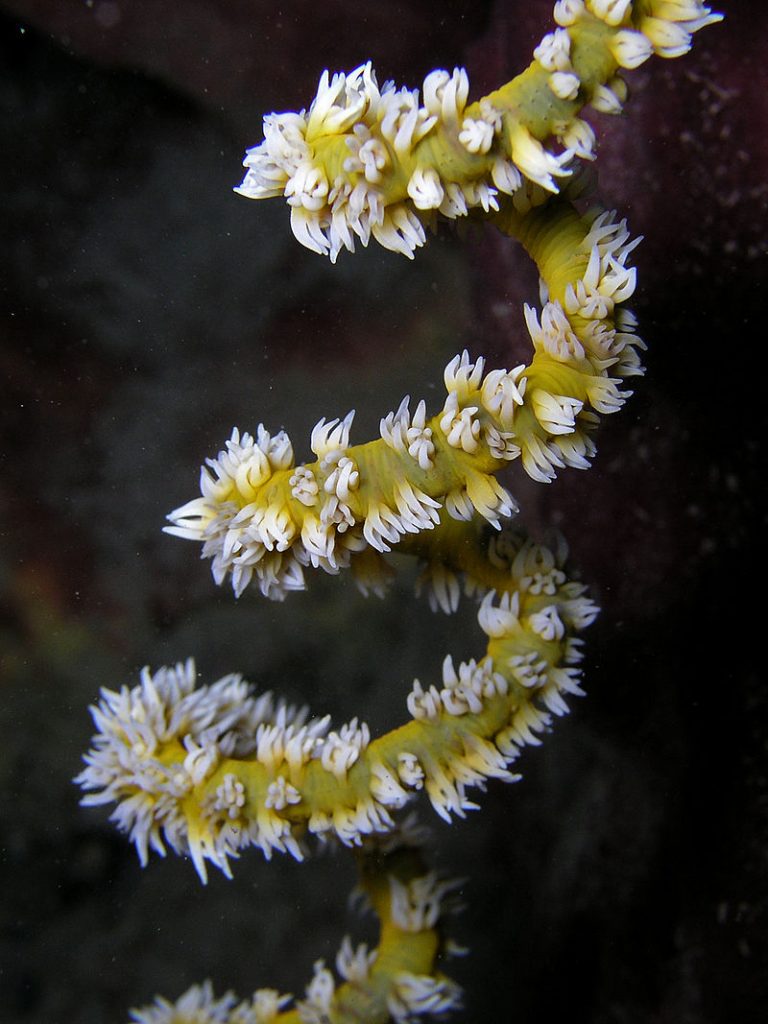
Spiral wire coral
Spiral wire coral
Nhobgood Nick Hobgood – Own work
Cirripathes sp. Spiral wire coral – Black coral


Brocken Inaglory – Own work
Plate coral (Fungia sp.). The picture was taken in Papua New Guinea

Nhobgood Nick Hobgood – Own work
English: Meandrina meandrites (Maze Coral
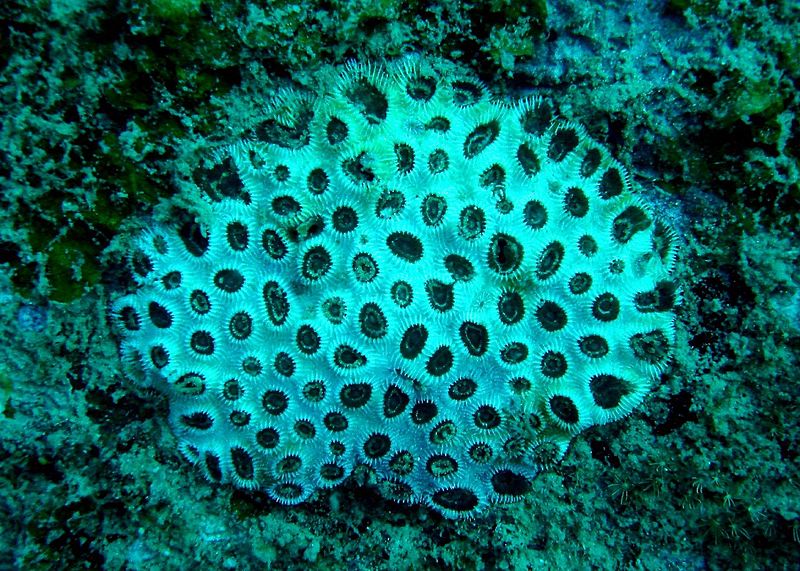
Aaron from Washington, DC, United States – black coral
it’s white underwater, but turns black when dried. used for jewelry
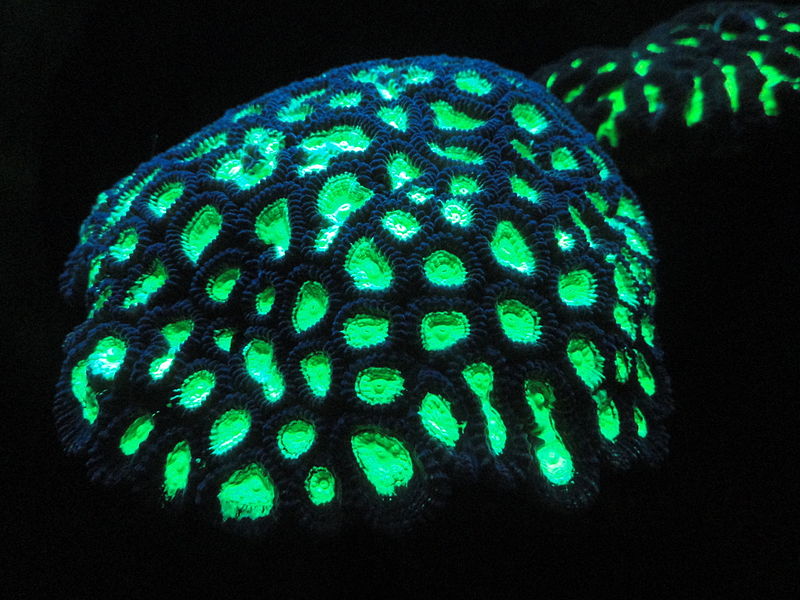
Fluorescent coral[67]
Daderot – Own work
Exhibit in the Monterey Bay Aquarium, Monterey County, California, USA
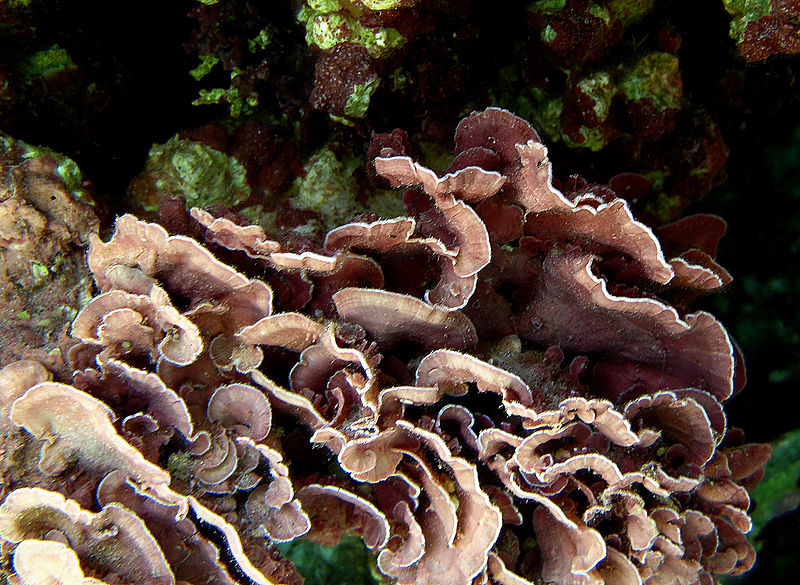
Corraline algae Mesophyllum sp.
Philippe Bourjon – The uploader on Wikimedia Commons received this from the author/copyright holder.
Une algue coralline du genre Mesophyllum à la Réunion.

Encrusting corraline algae
Philippe Bourjon – Don de l’auteur
Une algue encroûtante de la famille des Corallinaceae à la Réunion.
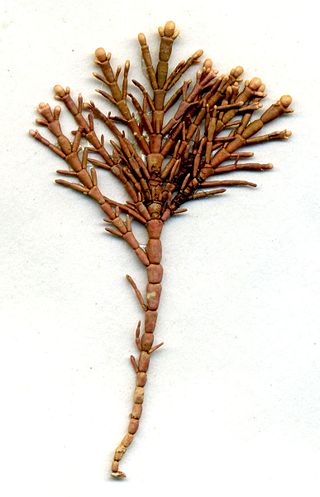
coralline algae Corallina officinalis
Gabriele Kothe-Heinrich – Own work
Corallina officinalis L., herbarium sheet. Collected 1985-09-10, Heligoland (Germany)
Coral reefs often depend on surrounding habitats, such as seagrass meadows and mangrove forests, for nutrients. Seagrass and mangroves supply dead plants and animals that are rich in nitrogen and serve to feed fish and animals from the reef by supplying wood and vegetation. Reefs, in turn, protect mangroves and seagrass from waves and produce sediment in which the mangroves and seagrass can root.[49]
Biodiversity
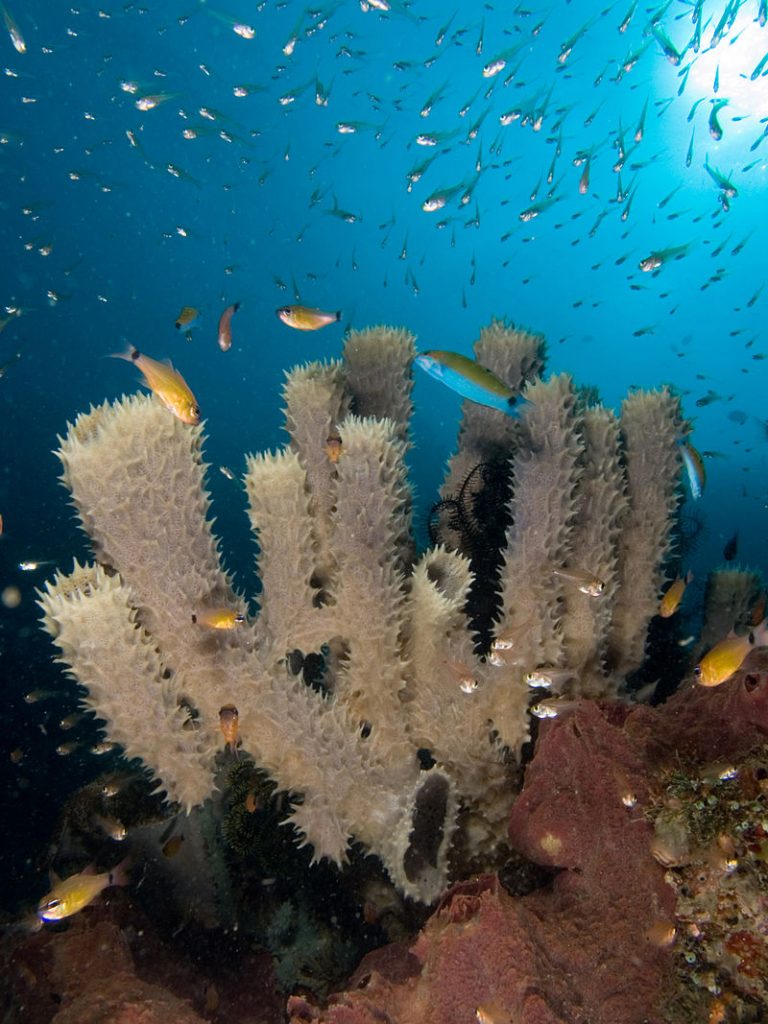
Tube sponges attracting cardinal fishes, glassfishes and wrasses
Nhobgood Nick Hobgood – Own work
Callyspongia sp. (Tube sponge) attracting cardinal fishes, golden sweepers and wrasses.

Over 4,000 species of fish inhabit coral reefs.
Fascinating Universe – Own work
Coral Reef
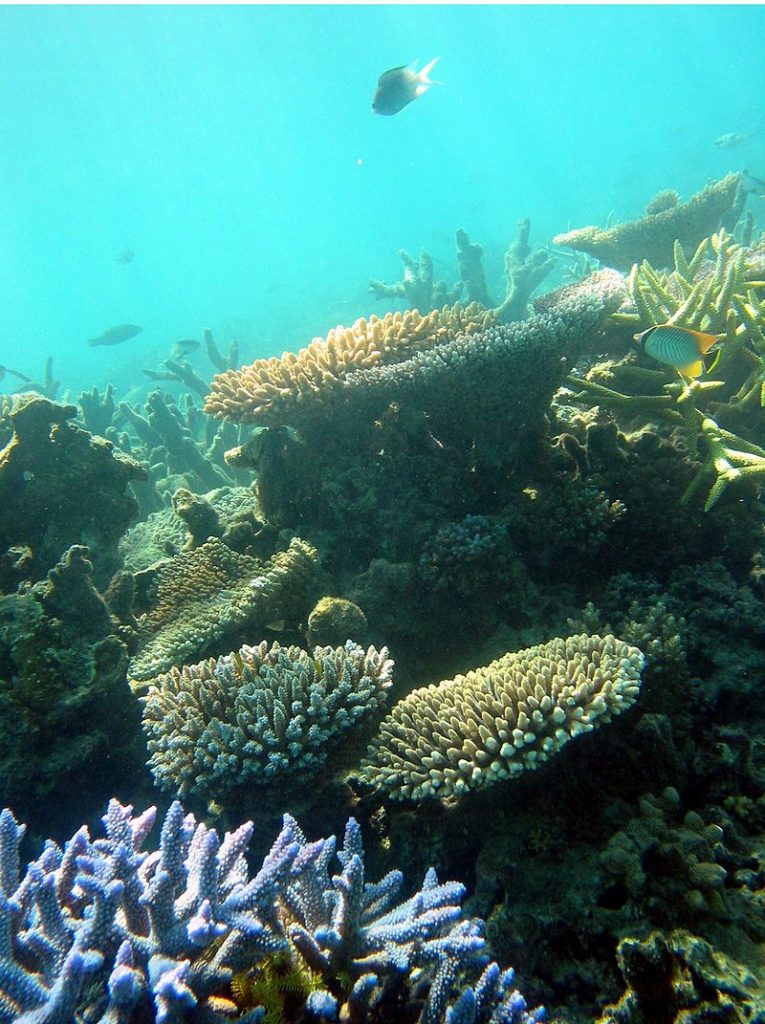
C Organisms can cover every square inch of a coral reef.
Photo courtesy of Terry Hughes. – Beyond Neutrality—Ecology Finds Its Niche. Gewin V, PLoS Biology Vol. 4/8/2006, e278 doi:10.1371/journal.pbio.0040278
Diverse Coral Reef Systems Serve As Ideal Experiments for Niche and Neutral Theories. Organisms cover every square inch of coral reef, which led many to believe that their limited potential to partition resources into niches would make them a prime example of neutral dynamics. In fact, species diversity was more variable than would be assumed by neutral theory.
oral reefs form some of the world’s most productive ecosystems, providing complex and varied marine habitats that support a wide range of other organisms.[103][104] Fringing reefs just below low tide level have a mutually beneficial relationship with mangrove forests at high tide level and sea grass meadows in between: the reefs protect the mangroves and seagrass from strong currents and waves that would damage them or erode the sediments in which they are rooted, while the mangroves and sea grass protect the coral from large influxes of silt, fresh water and pollutants. This level of variety in the environment benefits many coral reef animals, which, for example, may feed in the sea grass and use the reefs for protection or breeding.[105]
Threats

Island with fringing reef off Yap, Micronesia[134]
Mr. Ben Mieremet, Senior Advisor OSD, NOAA – Taken from https://www.photolib.noaa.gov/htmls/mvey0290.htm
Portion of a Pacific atoll (Yap) showing two islets on the ribbon or barrier reef separated by a deep pass between the ocean and the lagoon.
See also: Environmental issues with coral reefs and Coral bleaching
Coral reefs are dying around the world.[134] In particular, runoff, pollution, overfishing, blast fishing, disease, invasive species, overuse by humans and coral mining and the digging of canals and access into islands and bays are localized threats to coral ecosystems. Broader threats are sea temperature rise, sea level rise and ocean acidification, all associated with greenhouse gas emissions.[135] Other threats include the ocean’s role as a carbon dioxide sink, atmospheric changes, ultraviolet light, ocean acidification, viruses, impacts of dust storms carrying agents to far-flung reefs, and algal blooms.
Air pollution can stunt the growth of coral reefs; including coal-burning and volcanic eruptions.[136] Pollutants, such as Tributyltin, a biocide released into water from anti-fouling paint can be toxic to corals.
Protection
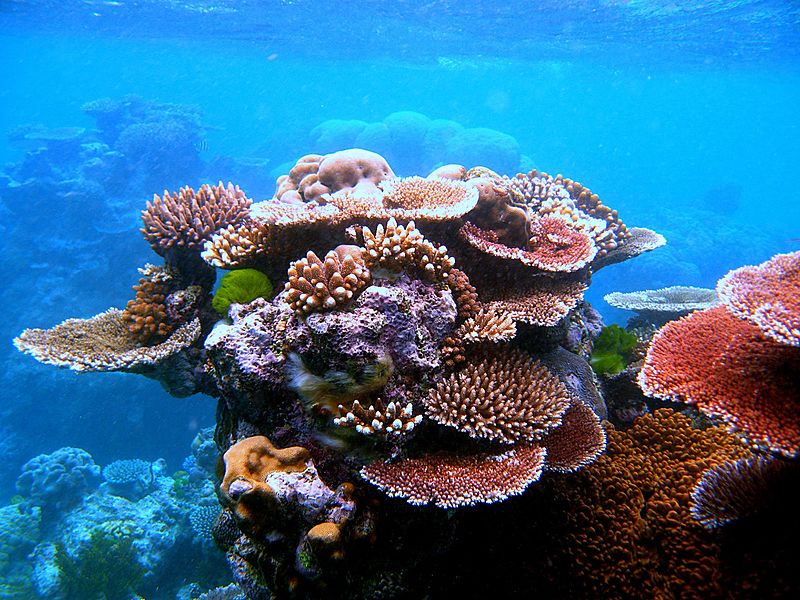
A diversity of corals
Toby Hudson – Own work
A variety of corals form an outcrop on Flynn Reef, part of the Great Barrier Reef near Cairns, Queensland, Australia.
Marine protected areas (MPAs) are designated areas that provide various kinds of protection to ocean and/or estuarine areas. They are intended to promote responsible fishery management and habitat protection. MPAs can encompass both social and biological objectives, including reef restoration, aesthetics, biodiversity and economic benefits.
For more information please visit the following link:
https://en.wikipedia.org/wiki/Coral_reef
Hundreds of meters below the surface of the ocean, Laura Robinson probes the steep slopes of massive undersea mountains. She’s on the hunt for thousand-year-old corals that she can test in a nuclear reactor to discover how the ocean changes over time. By studying the history of the earth, Robinson hopes to find clues of what might happen in the future.
This talk was presented to a local audience at TEDxBrussels, an independent event. TED’s editors chose to feature it for you.
About the speaker
Laura Robinson · Ocean scientist
About TEDx
TEDx was created in the spirit of TED’s mission, “ideas worth spreading.” It supports independent organizers who want to create a TED-like event in their own community.
1,731,991 views
TEDxBrussels | December 2014
Kristen Marhaver studies corals, tiny creatures the size of a poppyseed that, over hundreds of slow years, create beautiful, life-sustaining ocean structures hundreds of miles long. As she admits, it’s easy to get sad about the state of coral reefs; they’re in the news lately because of how quickly they’re bleaching, dying and turning to slime. But the good news is that we’re learning more and more about these amazing marine invertebrates — including how to help them (and help them help us). This biologist and TED Senior Fellow offers a glimpse into the wonderful and mysterious lives of these hard-working and fragile creatures.
This talk was presented at an official TED conference, and was featured by our editors on the home page.
About the speaker
Kristen Marhaver · Coral reef biologist
More Resources
Further reading
Learn more about the TED-at-sea hosted by TED Prize winner Sylvia Earle.
Watch more TED Talks about the wonder of our oceans — and the threats facing them.
885,450 views
Mission Blue II | October 2015
David Gallo shows jaw-dropping footage of amazing sea creatures, including a color-shifting cuttlefish, a perfectly camouflaged octopus, and a Times Square’s worth of neon light displays from fish who live in the blackest depths of the ocean. This short talk celebrates the pioneering work of ocean explorers like Edith Widder and Roger Hanlon.
This talk was presented at an official TED conference, and was featured by our editors on the home page.
About the speaker
TED2007 | March 2007
Margaret Wertheim leads a project to re-create the creatures of the coral reefs using a crochet technique invented by a mathematician — celebrating the amazements of the reef, and deep-diving into the hyperbolic geometry underlying coral creation.
This talk was presented at an official TED conference, and was featured by our editors on the home page.
About the speaker
https://www.ted.com/speakers/margaret_wertheim
Margaret Wertheim
By masterminding a project to model a coral reef armed only with crochet hooks, Margaret Wertheim hopes to bring some of the most complicated mathematical models embodied in our universe into the minds (and hands) of the masses.
Why you should listen
Snowflakes, fractals, the patterns
on a leaf — there’s beauty to be found at the intersection of nature and
physics, beauty and math. Science writer Margaret Wertheim (along with her
twin sister, Christine) founded the Institute for Figuring to advance the
aesthetic appreciation of scientific concepts, from the natural physics of
snowflakes and fractals to human constructs such as Islamic mosaics, string
figures and weaving.
The IFF’s latest project is perhaps its most beguilingly strange — a coral
reef constructed entirely by crochet hook, a project that takes advantage of
the happy congruence between the mathematical phenomena modeled perfectly by
the creatures of the reef, and repetitive tasks such as crocheting —
which, as it turns out, is perfectly adapted to model hyperbolic space.
It is easy to sink into the kaleidoscopic, dripping beauty of the yarn-modeled
reef, but the aim of the reef project is twofold: to draw attention to
distressed coral reefs around the world, dying in droves from changing ocean
saline levels, overfishing, and a myriad of threats; and to display a flavor of
math that was previously almost impossible to picture. By modeling these
complex equations in physical space, this technique can help mathematicians see
patterns and make breakthroughs.
Wertheim is now working on a book about maverick scientist James Carter.
What others say
“Margaret Wertheim might technically fall under the oh-so-banal title of a science communicator. But this fiery Australian native has roamed far beyond the standard definition of one who just talks about science.” — Kristin Abkemeier, Inkling Magazine
Gallery: Rebekah Barnett – What happens when you mix math, coral and crochet? It’s mind-blowing
Gallery: What happens when you mix math, coral and crochet? It’s mind-blowing
Jan 31, 2017 / Rebekah Barnett
- Click to share on Facebook (Opens in new window)
- Click to share on Twitter (Opens in new window)
- Click to share on LinkedIn (Opens in new window)
- Click to share on Pinterest (Opens in new window)
How two Australian sisters channeled their love of STEM and coral reefs into the most glorious participatory art project.
“We’re used to thinking about math as something you have to learn through textbooks and equations,” says science writer Margaret Wertheim. But through their Institute for Figuring, she and her sister, Christine, have made it their mission to help people see math and science differently by finding hands-on ways to engage them with abstract concepts. Among their efforts: the mesmerizing Crochet Coral Reef. Why crochet and coral? Many reef organisms are living examples of a complicated form of geometry, and crocheting their shapes allows people to work with geometric principles in a tactile way.
Started in 2007, the Wertheims’ reef grew out of the Australian sisters’ many interests: their passion for math and science; shared fondness for crochet; love of their country’s Great Barrier Reef and desire to highlight global warming’s impact on coral reefs and oceans in general. Today the Crochet Coral Reef is made up of thousands of handcrafted corals and reef organisms — created by a network of contributors — that Margaret and Christine, an artist and professor, have curated into displays that have been exhibited worldwide. Here, Margaret Wertheim shares some of the amazing organisms created for their project and shows how their crocheted reef has grown and evolved over the years.

Photo: Institute For Figuring.
Math like you’ve never seen it before
Many reef organisms, like nudibranches, sponges and kelps, possess structures that embody a head-scratching form of geometry called hyperbolic geometry. Hyperbolic geometry was discovered in the 19th century, revolutionizing the field of mathematics and eventually paving the way for Einstein’s general theory of relativity. Yet physical and durable hyperbolic models that would allow people to explore hyperbolic geometry in a tactile way did not exist until 1997 when Dr. Daina Taimina, a mathematician at Cornell, realized forms could be made using crochet. To create this 18-inch-long hyperbolic shape, artist Siew Chu Kerk followed Taimina’s formula pretty exactly, says Wertheim, “which is crochet n stitches, increase one and then repeat that ad infinitum.”

Photo: Institute for Figuring.
They’re more than hyperbolic
The Wertheim sisters first called their project the Hyperbolic Crochet Coral Reef, but they quickly realized that in order to capture the full beauty of this special ecosystem, they’d need to include organisms that lacked hyperbolic features. Some reef creatures have only a few hyperbolic parts (and some display no hyperbolic geometry at all). For example, the curlicues at the end of this octopus-like creature’s tentacles and its center are hyperbolic shapes, Wertheim says, but other elements of this organism, like the long parts of the tentacles, are not. Helen Bernasconi, an early contributor to the project and a rug weaver by trade, sheared, spun and dyed wool from her own sheep to make this piece.

Photo: Institute for Figuring.
Bringing art into the equation
While this delightful pastel creation, made by Vonda N. McIntyre, is a crocheted replica of fingerling coral, not all contributors hew so closely to reality. This was a deliberate artistic choice on the part of the Wertheim sisters. “Just as a painter is painting a landscape and doesn’t want to produce a photocopy of it, we want to be like Van Gogh, Cézanne or Monet,” says Wertheim. “We’re trying to look at the world and produce a beautiful aesthetic version.”

Photo: Institute for Figuring.
A branching network of makers
This kelp piece shows the technical skill of Ildiko Szabo, a theater costume designer and another of the project’s earliest contributors. After she and Christine came up with the idea of such a reef, Wertheim recalls, “I put something up on [the Institute of Figuring’s] website saying: Is there anyone else who’d like to join us in this quixotic project at the intersection of handicraft, mathematics and environmentalism?” To their surprise and delight, they began receiving crocheted objects in the mail from people they’d never met. Years later, Szabo remains one of the reef’s 40 to 50 core contributors. Altogether, nearly 100 people — whose ranks include sci-fi writers and computer programmers — are behind the roughly 10,000 pieces that make up the reef.
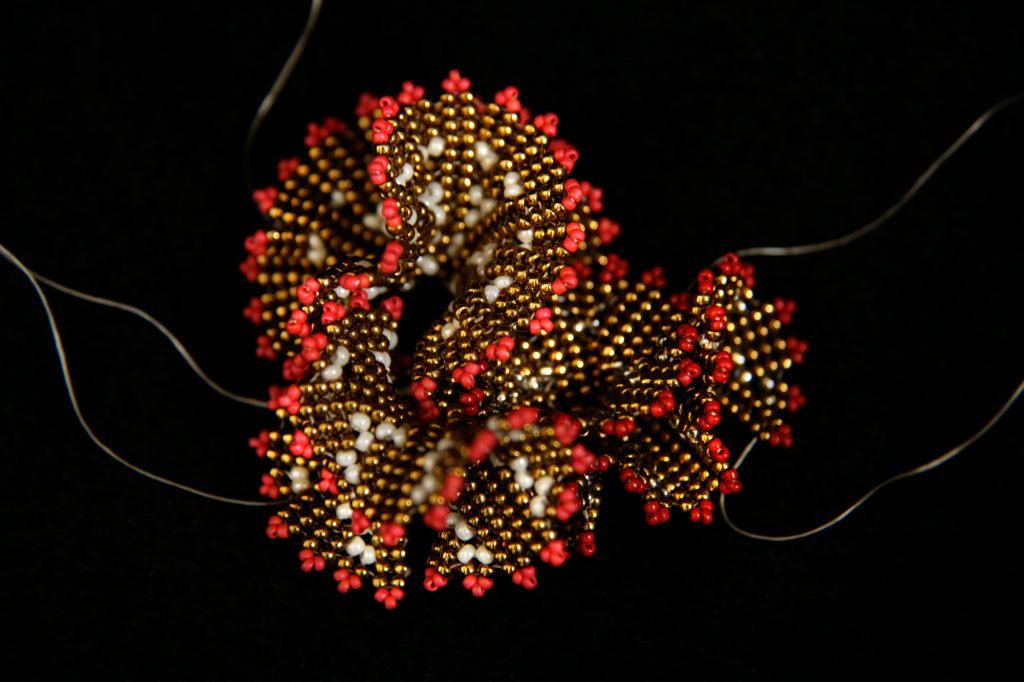
Photo: Institute for Figuring.
Small pieces, major work
Rebecca Peapples created this beaded piece (which is attached to the center of the white star in the next photo) using a traditional beading stitch called the herringbone. While only around three inches in length, Wertheim estimates that Peapples spent around 10 to 15 hours to produce it (pieces in the reef range in size from a few inches to a few feet). The white star, about the size of a human hand, probably took up to 30 hours to make; some pieces have taken hundreds of hours. “One reason why I think the reef is powerful is because everybody can tell when they walk in the door there has been a huge commitment of time,” she says.
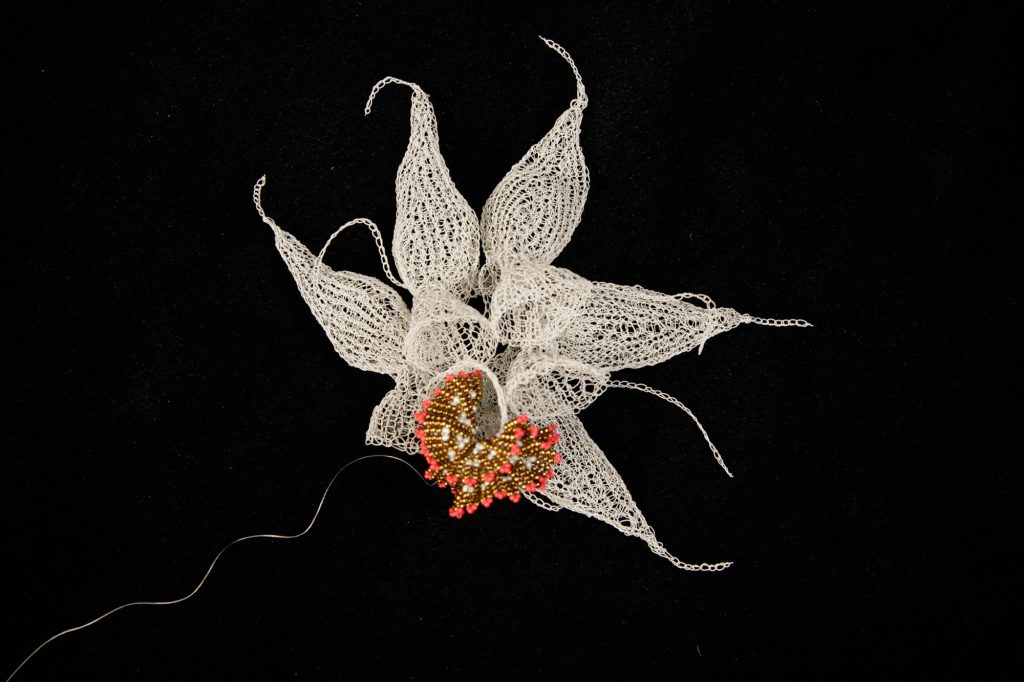
Photo: Institute for Figuring.
The delicate fusion of craft and science
This piece, knitted by Anita Bruce using a fine coated wire, was her attempt at using handicraft to mimic the evolutionary process. Bruce began with a simple shape, like the thin pods sticking out from the angles of the star, and then let a random number generator determine how to continue to create the shape. This Darwinian echo is something that Wertheim sees across the Crochet Coral Reef as a whole. “Every
[contributor]
starts by learning how to do a simple hyperbolic structure,” she explains, a shape she compares to a simple cell. But just like evolution, crocheters go from the simple to ever-more complicated structures.
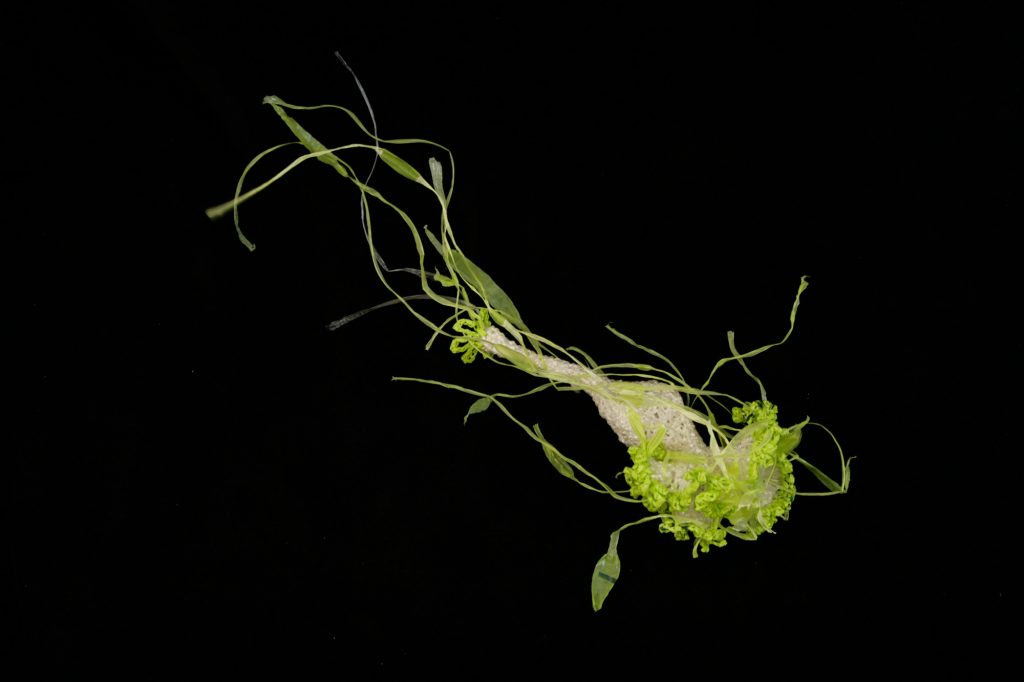
Photo: Institute for Figuring.
Our future is plastic
In addition to warming ocean temperatures, another major threat facing marine ecosystems is plastic. After starting the reef, the Wertheim sisters learned about the Great Pacific Garbage Patch, and they responded with the Toxic Reef, a collection of organisms — like this jellyfish — that were crocheted or knitted out of plastic. Learning about the garbage patch also inspired the Wertheims to keep all of their domestic plastic trash for four years, accumulating a total of 440 pounds. They contained this trash in a net, and it’s now displayed as part of the reef under the name “The Midden.” Common reactions from visitors are amazement and disgust. To the latter group, Wertheim says, “If you don’t like it, think about it — the yarn reefs represent the natural beauty of nature that’s rapidly disappearing, and the plastic represents the future of what humanity is creating.” This jellyfish was crocheted from plastic bin-liners by Wertheim.
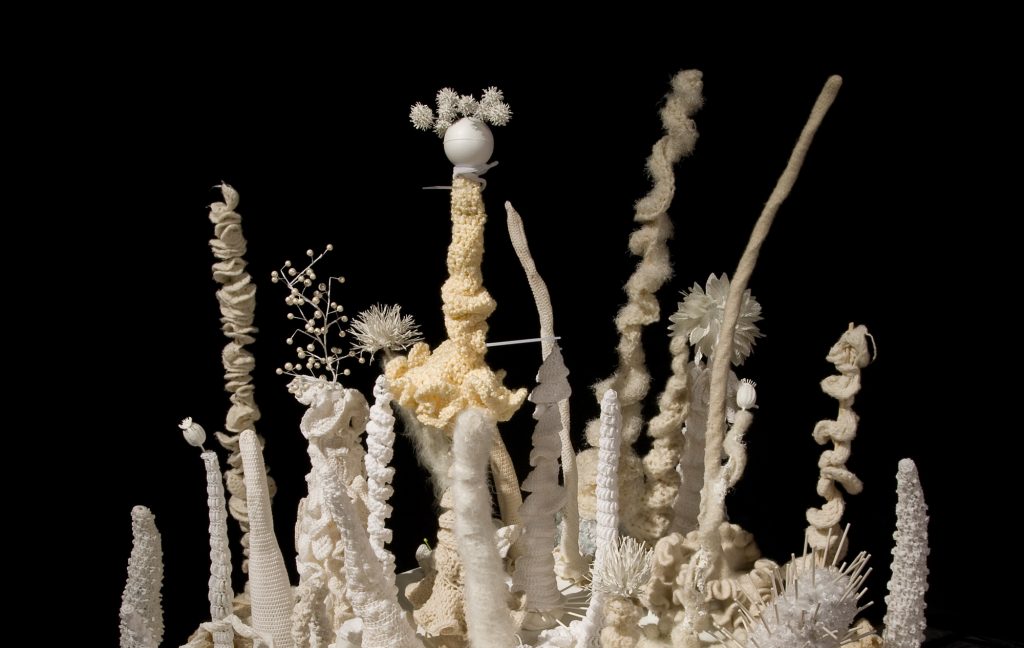
Photo: Institute for Figuring.
Death’s white beauty
These stunning pale pieces were made by Evelyn Hardin, which Ann, another Wertheim sister, organized into a long grove. While the monochromatic grove is enchanting to look at, it illustrates a deadly ocean phenomenon: coral bleaching. When corals become stressed by factors like acidification and rising temperatures, they expel the symbiotic zooxanthellae algae that gives them their bright color and turn bone-white. The algae also help provide food for corals, so without them, they become more and more vulnerable and can die. The Wertheim sisters have curated two reefs, the Bleached Reef and the Bleached Bone Reef, to spotlight this increasingly urgent problem (in November, scientists announced the largest coral die-off in the Great Barrier Reef ever recorded). Should coral reefs perish altogether, Wertheim believes the crocheted reef would stand as an extraordinary testament to the beauty of the reefs — and an extraordinary indictment of humanity for destroying them. “It would become like a museum artifact of yet another thing that humans, with our inability to limit ourselves, have wiped off the face of the Earth,” she says.
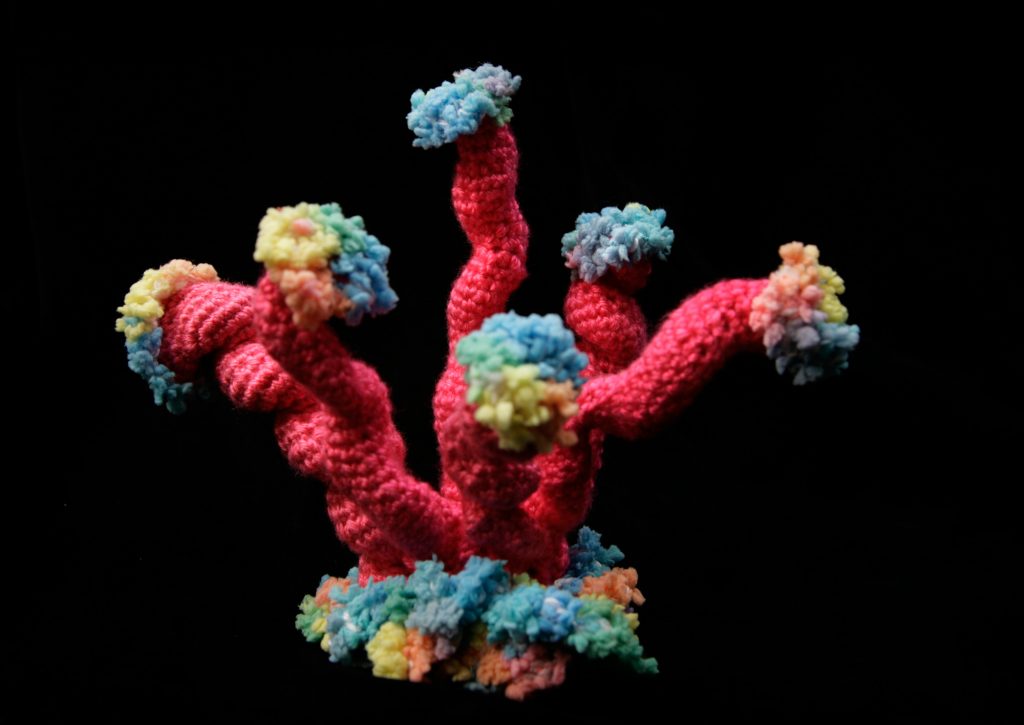
Photo: Institute for Figuring.
A playful, pastel reef
While the Crochet Coral Reef conveys serious messages about the degradation of the marine ecosystem, the sisters also want the reef to be playful and engaging. One example: these tube worms, crafted by Szabo in a vibrant mix of pastels and neons. The sisters hope to raise awareness about climate change through positive means rather than messages of doom and gloom. Upon seeing their reef, Wertheim says, “people’s first reaction is usually to laugh, and we want that.” That playful spirit helps bring visitors and crocheters into a conversation “about these very difficult, destructive processes going on where reefs are in danger of being wiped out.”
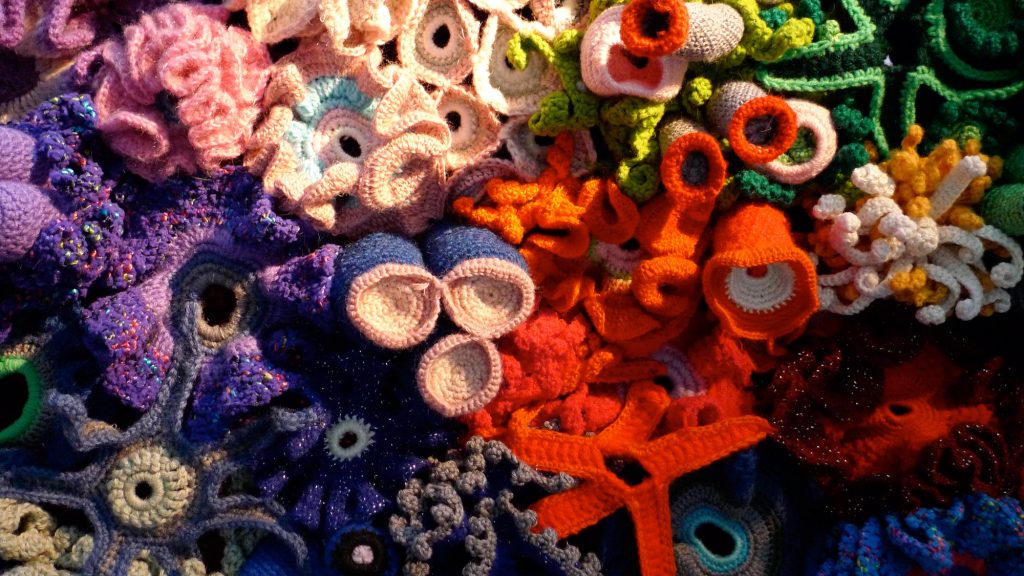
Photo: Institute for Figuring.
The power of the people
Besides the reefs curated by the sisters, their project has expanded to encompass dozens of community reefs in 40 cities around the world from Oslo to Adelaide, from Fukuoka to San Antonio. They are in a number of different of places, including the Smithsonian in Washington, DC, prisons, and homes for the disabled. This collection of organisms, all created by Dagnija Griezne, is just one section of a Latvian community reef, a project spearheaded by artist Tija Viksna. Women from all over the country contributed, as well as more than 600 schoolchildren. One common thread that links all the reefs in the project — whether it’s the Wertheims’ curated displays or the community reefs — has been their collective nature. “You get an artwork that’s much, much greater than any individual artist could’ve achieved by themselves,” says Wertheim. Students, faculty and staff at the University of California Santa Cruz are crafting the latest community reef, and these human-made ecosystems keep spreading. “We never quite know who’s going to do it next,” adds Wertheim.
All photos are from the Crochet Coral Reef project by Margaret and Christine Wertheim and the Institute for Figuring. To learn more about exhibitions, satellite reefs and contributors, go to crochetcoralreef.org
About the author
Rebekah Barnett is the community speaker coordinator at TED, and knows a good flag when she sees one.
Leave a Reply